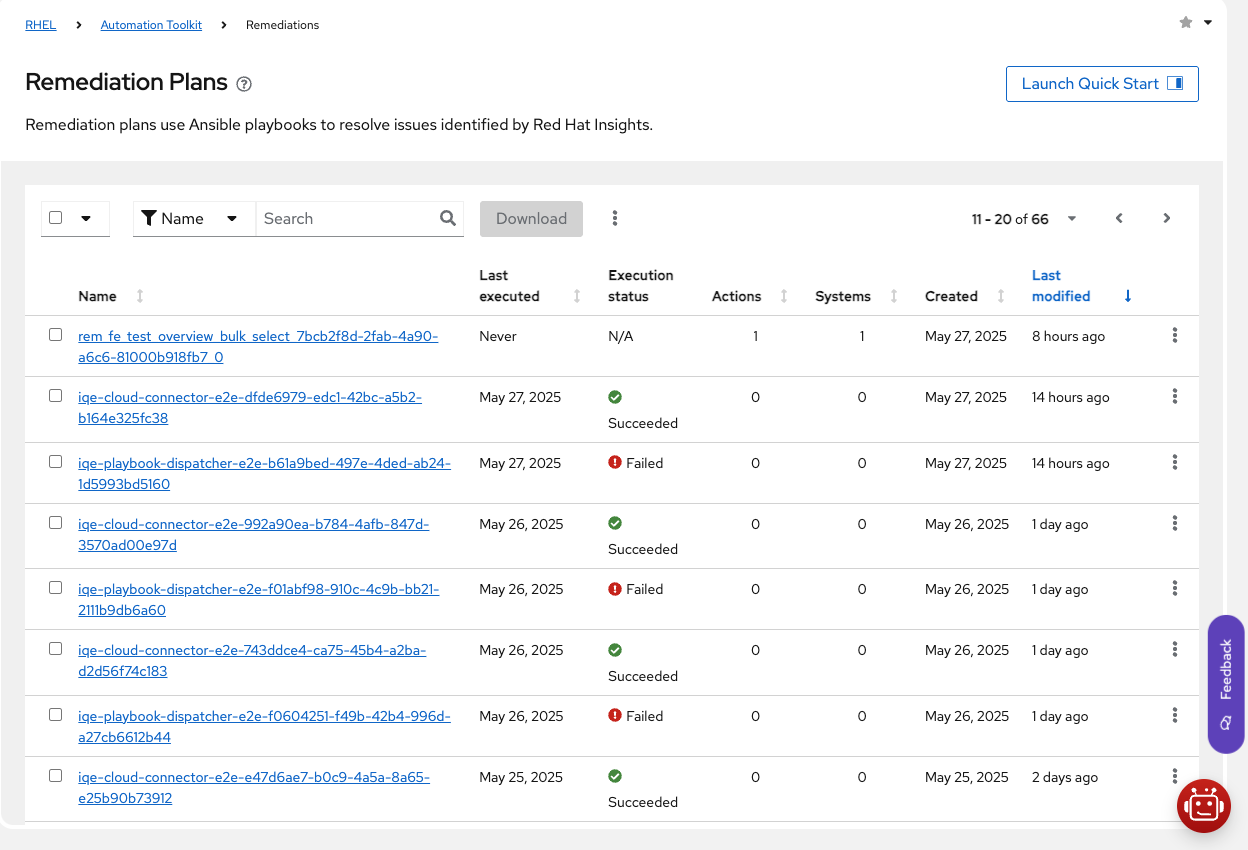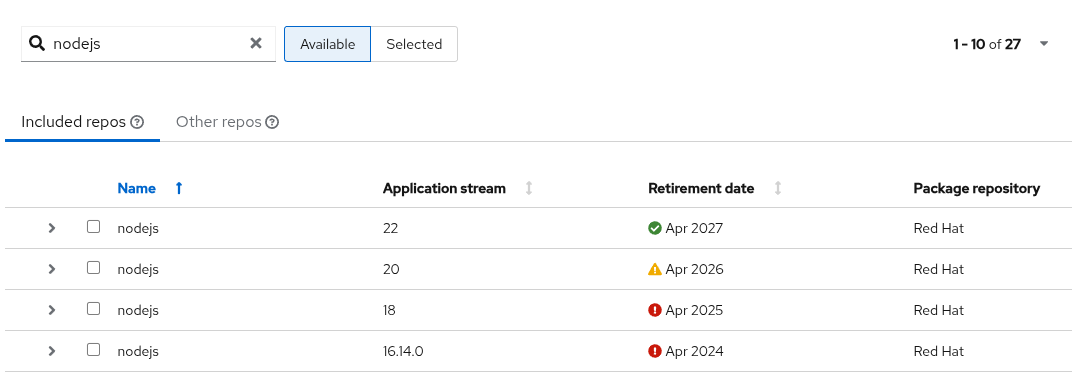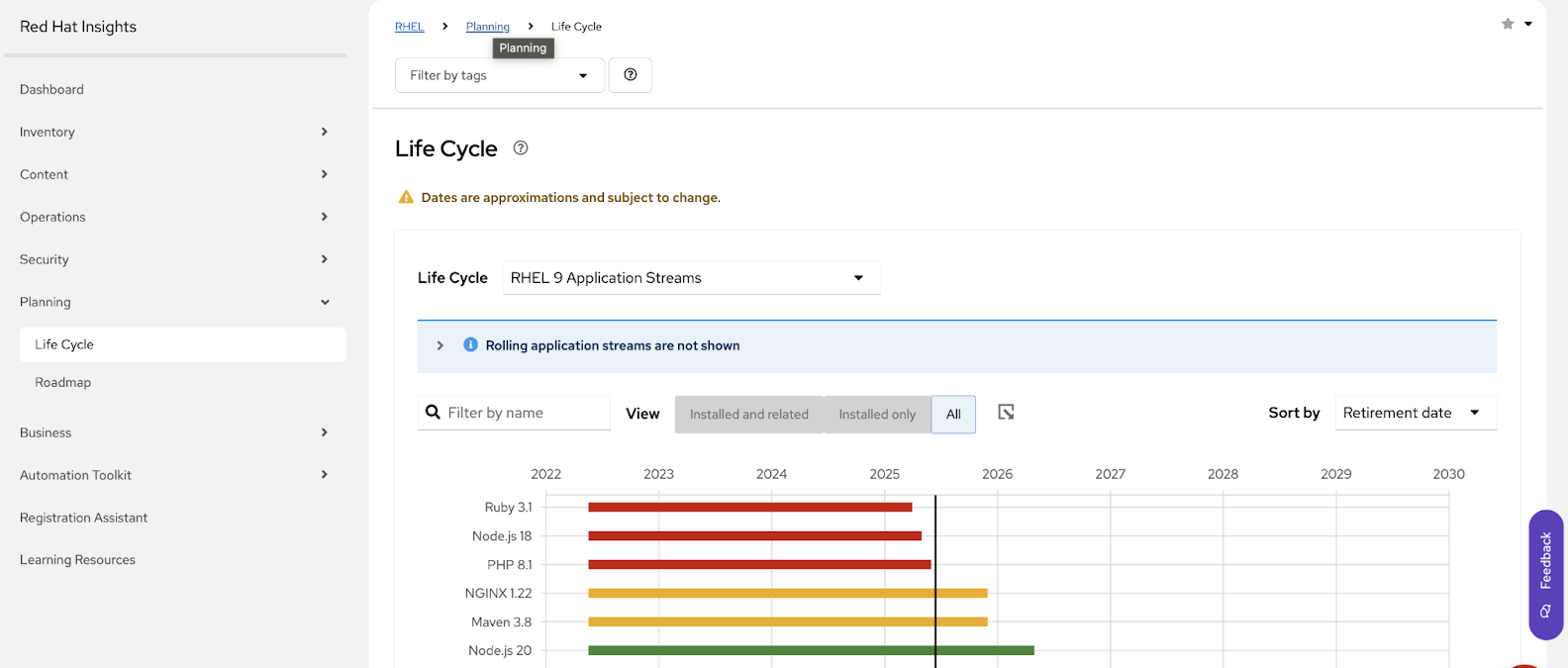Chapter 6. May 2025
6.1. Product-wide updates
6.1.1. Published blogs and resources
- Blog post: How Insights events enhance system life cycle management by Jerome Marc (May 13, 2025)
- Blog: What’s new in image builder for Red Hat Enterprise Linux 10 by Terry Bowling (May 20, 2025)
- Updated Resource: Red Hat Insights API Cheat Sheet by Jerome Marc (May 2025)
- Press Release: Red Hat Introduces AI-Powered Management and Extends Container-Native Reach for Red Hat Enterprise Linux (May 20, 2025)
6.1.2. General
Red Hat Insights API cheat sheet updated
The Red Hat Insights API Cheat Sheet was updated with expanded coverage, improved clarity, and new resources to help you make the most of the Insights API. Key changes include:
- New Image Builder section with a POST example and blog link
- New Repositories and Content Templates section
- Improved Inventory descriptions and request optimization tips
- Updated Subscriptions section with corrected examples and export guidance
- Links to helpful resources, including the API Token authentication KB article and the new Using Red Hat Insights API guide
- Additional Compliance v2 API queries, such as assigning systems to policies
Red Hat account login using emails as usernames deprecated
You can no longer log in to your Red Hat account with your email unless your email is your Red Hat login. For more information, see Finding your Red Hat login.
6.2. Red Hat Insights for Red Hat Enterprise Linux
6.2.1. RHC / Insights Client
Functional levels with RHC client
RHC is now the official and recommended tool for registering RHEL 10 systems to the Hybrid Cloud Console. This update with RHEL 10 allows users to enable or disable features during registration, providing control over the amount of data collected from the system.
The details of the new functionalities can be found in the Remote Host Configuration and Management guide. In addition, the output of the rhc connect subcommand has been updated to reflect those changes:
6.2.2. Remediations
Table view for all remediation plans
Remediation plans in Insights now feature a searchable, sortable, and filterable table view, mirroring the rest of the Insights experience. This new format streamlines the process of locating specific plans, especially beneficial when handling numerous plans, by enabling users to define and apply criteria for their searches.
Quick start guide: Creating and executing remediation plans
A new quick start guide is available to help you get started with remediations. The guide helps you navigate the process of creating a remediation plan for advisor issues, confirming execution readiness, and executing the remediation plan on direct-connected hosts.
When you open the quick start, the quick start panel expands on the right side of the screen and persists as you navigate to other pages within Insights. You can launch the quick start from the Remediations page on console.redhat.com or in the Learning Resources page.
In-app execution readiness guidance
Remediation plan details now include a new Execution readiness card. This card offers a clear, step-by-step checklist of the permissions and configuration settings required for successful remote host execution. If any of your configuration settings are incorrect, the card specifies the exact steps needed for proper setup.
Execution History tab
The new Execution History tab provides a streamlined way to monitor the progress of acting on remediation plans. You can now access the status, history, and logs of a plan execution on each included system.
Additional fixes and enhancements
The following features have been implemented to improve Remediations:
- About remediations infotip: A new infotip on the overview page offers a quick description and direct links to documentation. This infotip is helpful if you’re new to Insights or in need of a quick refresher.
- Cleaner execution results: The broken issue counter in the details of a remediation plan has been removed for clarity.
- Consistent language: The Remediate button shown within Insights service pages has been renamed to the more accurate Plan remediation.
- Clearer labeling: We’ve removed the Ansible logo from the Playbook column (now called Remediation type) to better communicate that an Ansible subscription is not required to use remediations.
6.2.3. Inventory
UI fixes and improvements
Several updates and fixes have been implemented to improve Inventory, including:
- Group Creation Error Resolved: Attempting to create a group with a name that already exists no longer results in a server error.
- Group Rename Sync: Renaming a group is now properly reflected in the workspace interface.
-
Inventory Sorting Fixed: Sorting inventory groups by
host_countnow behaves as expected. - Inventory Helper Modal Update: The Inventory helper modal dialog box now includes guidance and a link to Configuring notifications for inventory events.
- Improved API Visibility: The Inventory API documentation now includes a direct link to Using the Red Hat Insights API product documentation.
6.2.4. Advisor
New recommendations released
The Red Hat Insights Advisor service now detects and recommends solutions for the following issues:
-
Kdumpfails to savevmcoreon edge computing systems with AMD CPUs due to a known bug in the default kernel - High latency occurs when the cgroup update functions are called concurrently on RHEL 8 edge computing systems
- The system hangs due to improper I/O statistics on the edge computing system when a multipath device is in use
- Network packets are at risk of drop on a Broadcom NetXtreme II BCM57810 NIC after reboot when the network offloading feature is enabled and the firmware version is incompatible with the kernel version
-
This system cannot work as expectedmessage when encounteringsmartderrors - Boot failure occurs when local disks used for the root filesystem are not configured in the denylist
- Kernel panics after reboot on edge computing systems when the DFS Target Server is down
6.2.5. Tasks
RHEL AI Update Task
You can now update a connected RHEL AI system using the Insights tasks service. Options include triggering a z-stream update or a minor version update to a supported version of RHEL AI. The Insights tasks service highlights systems running an unsupported RHEL AI version to help you quickly identify which systems need attention.
6.2.6. Image Builder
Image builder now shows AppStream lifecycle information
Image builder now shows lifecycle information for AppStreams that have multiple versions available. This enables customers to select an AppStream version with a lifecycle that aligns with their needs.
6.2.7. Planning
Insights planning for RHEL is now generally available
Red Hat Insights planning for Red Hat Enterprise Linux (RHEL) is now available, delivering new features designed to assist with planning RHEL upgrades and monitoring the RHEL lifecycle status. In addition, Insights planning provides visibility into the tentative future roadmap for RHEL.
Insights planning introduces two new features:
- Life Cycle: Provides a centralized lifecycle view for Application Streams and RHEL minor releases, which helps you to plan for upgrades and monitor the status of your environment.
- Roadmap: Provides a view into the tentative roadmap for RHEL, enabling you to better plan ahead, and to anticipate the impact of upcoming roadmap items.






